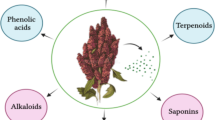Abstract
Four different genotypes of Glycine max, viz Rawal-I, NARC-II, SA-72-60 and Ajmeri, were subjected to antimicrobial investigation in the present study. Three types of extracts, i.e. aqueous, methanol and peptide, were prepared from the seed powder of each variety. Extracts were tested for their antimicrobial ability by agar well diffusion assay against 3 g-positive strains, i.e. Streptomyces laurentii, Enterococcus faecium and Microbacterium oxydans, and four gram-negative strains, i.e. Pseudomonas geniculata, Alcaligenes faecalis, Klebsiella pneumoniae and Bacillus subtilis. Rawal-I and NARC-II exhibited maximum antibacterial activity at higher concentrations with dose-dependent relationship against Streptomyces laurentii and Pseudomonas geniculata, whereas SA-72-60 and Ajmeri were found ineffective against all tested strains. Among three extracts prepared, aqueous and peptide extracts \({(12\pm0.14\,{\rm mm},\,11\pm0.07\,{\rm mm})}\) were more effective as compared to methanolic extracts. Different combinations of Rawal-I and NARC-II in 1:2 and 2:1 ratios were tested for antibacterial efficacies which exhibited no synergistic activity with few exceptions where antagonist interaction was shown by some of the extract mixtures. Preliminary phytochemical analysis of the effective extracts revealed the presence of antimicrobial constituents like flavonoids, alkaloids and saponins.
Similar content being viewed by others
References
Masuda T., Goldsmith P.: World soybean production: area harvested, yield, and long-term projections. Int. Food and Agribus. Manage. Rev. 12, 143–162 (2009)
Arora M., Singh S., Kaur R.: Phytochemical analysis, protein content & antimicrobial activities of selected samples of glycine max linn. Int. J. Res. Eng. Technol. 2, 570–574 (2013)
Behloul N., Wu G.: Genistein: a promising therapeutic agent for obesity and diabetes treatment. Eur. J. Pharmacol. 698, 31–38 (2013)
Massey L., Palmer R., Horner H.: Oxalate content of soybean seeds (Glycine max: Leguminosae), soyfoods, and other edible legumes. J. Agric. Food Chem. 49, 4262–4266 (2001)
Iqbal Z., Arshad M., Ashraf M., Naeem R., Malik M., Waheed A.: Evaluation of soybean (L. Merr.) germplasm for some important morphological traits using multivariate analysis. Pak. J. Bot. 42, 971–976 (2010)
Parekh J., Jadeja D., Chanda S.: Efficacy of aqueous and methanol extracts of some medicinal plants for potential antibacterial activity. Turk. J. Biol. 29, 203–210 (2005)
Ribeiro S.F., Carvalho A.O., Da Cunha M., Rodrigues R., Cruz L.P., Melo V.M., Vasconcelos I.M., Melo E.J.T., Gomes V.M.: Isolation and characterization of novel peptides from chilli pepper seeds: antimicrobial activities against pathogenic yeasts. Toxicon. 50, 600–611 (2007)
Sen A., Batra A.: Evaluation of Antimicrobial Activity Of Different Solvent Extracts Of Medicinal Plant: Melia Azedarach L. Int. J. Curr. Pharm. Res. 4, 67–73 (2012)
Lambert R., Pearson J.: Susceptibility testing: accurate and reproducible minimum inhibitory concentration (MIC) and non-inhibitory concentration (NIC) values. J. Appl. Microbiol. 88, 784–790 (2000)
Agboke A., Esimone C.: Antimicrobial evaluation of the interaction between methanol extract of the lichen, Ramalina Farinacea (Ramalinacea) and Ampicilin against clinical isolates of Staphylococcus Aureus. J. Med. Plants Res. 5, 644–648 (2011)
Iqbal, E.; Salim, K. A.; Lim, L. B.: Phytochemical screening, total phenolics and antioxidant activities of bark and leaf extracts of Goniothalamus velutinus (Airy Shaw) from Brunei Darussalam. J. King Saud Univ. Sci. (2015)
Bradford M.: A Rapid and Sensitive Method for the Quantitation of Microgram Quantities of Protein Utilizing the Principle of Protein-Dye Binding. Anal. Biochem. 72, 248–254 (1976)
Saleem M., Nazir M., Ali M., Hussain H., Lee Y., Riaz N., Jabbar A.: Antimicrobial natural products: an update on future antibiotic drug candidates. Nat. Prod. Rep. 27, 238–254 (2009)
Marlow V., Haag A., Kobayashi H., Fletcher V., Scocchi M., Walker G., Ferguson G.: Essential Role for the BacA Protein in the Uptake of a Truncated Eukaryotic Peptide in Sinorhizobium meliloti. J. Bacteriol. 191, 1519–1527 (2009)
Mattiuzzo M., Bandiera A., Gennaro R., Benincasa M., Pacor S., Antcheva N., Scocchi M: Role of the Escherichia coli SbmA in the antimicrobial activity of proline-rich peptides. Mol. Microbiol. 66, 151–163 (2007)
Hassan S.M., Haq A.U., Byrd J.A., Berhow M.A., Cartwright A.L., Bailey C.A.: Haemolytic and antimicrobial activities of saponin-rich extracts from guar meal. Food Chem. 119, 600–605 (2010)
Edewor T., Ibikunle G., Usman L.: Phytotoxic and antimicrobial screening of Saponin isolated from ethanolic leaf extract of Xylopia aethipioca. Sci. Focus. 14, 507–512 (2009)
Author information
Authors and Affiliations
Corresponding author
Rights and permissions
About this article
Cite this article
ul Ain, N., Safdar, N. & Yasmin, A. Antimicrobial Investigations from Crude and Peptide Extracts of Glycine max Linn. Merr Varieties. Arab J Sci Eng 42, 105–113 (2017). https://doi.org/10.1007/s13369-016-2248-6
Received:
Accepted:
Published:
Issue Date:
DOI: https://doi.org/10.1007/s13369-016-2248-6




